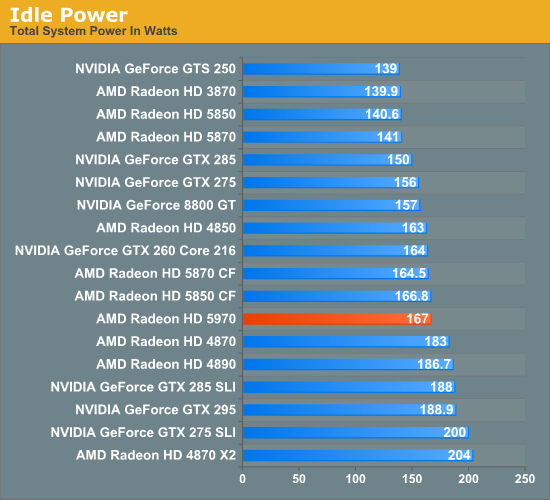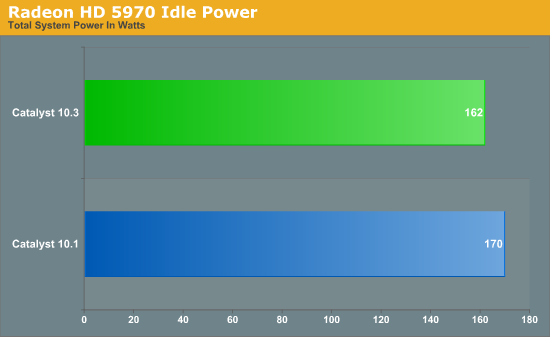What's New: AMD's Catalyst 10.2 & 10.3 Drivers
by Ryan Smith on February 16, 2010 12:00 AM EST- Posted in
- GPUs
10.2: Ultra Low Power State Confusion & Crossfire Eyefinity
When AMD was first briefing us on the 10.2 drivers, one of the first things they discussed was Ultra Low Power State (ULPS) support – this was probably a mistake. In our initial Radeon HD 5870 article covering the whole Evergreen architecture we discussed ULPS, albeit not under that name. ULPS was one of the many features AMD had briefed us about in September when they introduced the 5000 series, where ULPS allows AMD to power down the slave card(s) in a Crossfire configuration to a state even lower than idle. For the 5870/5970, this meant being able to reduce the slave(s) from 27W at idle to 20W under ULPS. This is only a 7W difference, but combined with other idle-efficient hardware it can become a notable difference. At the time it had been our understanding that this feature was enabled right out of the gate.
So imagine our confusion when at CES AMD is telling us that they are just enabling that feature for the entire 5000 series. Until that moment as far as we knew this feature was already enabled.
This started an almost immediate chain of confusion between ourselves and AMD. Terry Makedon – AMD’s Manager of Software Product Management – was giving the presentation and found himself at the end of an odd stare from us rather quickly. When we asked for clarification on this, he said that this feature was just finally going to be enabled in the mainstream Catalyst drivers, and that previously it had only been enabled for the 5970 in the launch drivers for that card. After expressing our displeasure on the issue, we quickly moved on due to time constraints.

The Radeon HD 5970: The card ULPS was practically made for
This brings us to February, where we started work on this article after wrapping up the Radeon HTPC investigation last week. Seeking further clarification on the issue and to once again express our displeasure with how this was handled, we sent an email to our favorite PR contact over at AMD, Evan Groenke. Evan has only been AMD’s PR frontman for hardware editors since the start of the year, and he’s been the guy largely responsible for helping us nail down all the issues we were seeing with the new Radeon 5000 series cards in HTPC use.
After sending that email early Friday morning, we got a phone call from Evan later that day… from the ski slopes. What was supposed to be a long weekend for him turned out to be a bit of a working weekend as he did what he could to dig in to the issue and to find a better explanation for us. Thanks to him we have a solid explanation on what’s going on and why our earlier tests were not as compromised as we once thought they were.
The key issue for AMD is that they did not consider the software side of ULPS to be ready for public use when the 5000 series launched, so it was not enabled in the Catalyst drivers at the time. ULPS was then enabled for the 5970 launch, where AMD was confident it was going to work correctly under the very limited conditions encountered by a single-card dual-GPU setup. But this was only enabled for the launch driver for the 5970 – it was never enabled in the mainline Catalyst drivers.
The issue for us, and why we were initially so displeased, was that it had never been communicated to us that ULPS wasn’t enabled from the beginning. We thought that it was enabled, AMD thought we knew that it wasn’t. So when we did our testing of the 5700, 5800, and 5900 series, we based all of our data on the idea that this feature was enabled, when in retrospect it wasn’t. Worse, it was enabled on the drivers we used to test the 5970 but not the 5870/5850, so our results would have the 5970 consuming less power at idle than what a real user would get if they used the mainline Catalyst drivers. This makes the results invalid, and was the source of our concerns.

Our original 5970 results
All of this was finally clarified when Evan was able to tell us two things: that the driver set we used to test the 5970 had been posted as a hotfix driver for the 5970 launch, and that it wasn’t the only driver with ULPS enabled. The former is of particular importance since coming from CES our interpretation had been that ULPS was not enabled on any public driver build, when in fact it just hadn’t been enabled on any mainline driver build – it had in fact been available in public hotfixes such as the 5970 launch driver. The latter is important because it was an undocumented feature of the 9.12 hotfix, which as we explained earlier is the precursor to much of what’s in the 10.2 driver being released today. So if you used the 9.12 hotfix, then you’ve already been enjoying ULPS on your 5000-series Crossfire setups.
With that in mind, here’s what the issue ultimately boils down to: Unless you were using the 5970 launch driver or the 9.12 hotfix, you have not been enjoying the benefit of ULPS. Specifically, unless you have used those drivers your idle power usage on the 5970 would have been around 7W higher than what we found in our initial 5970 review. It’s only now with today’s 10.2 driver that this is finally being enabled for customers using the mainline driver. If that’s you, then the 10.2 drivers should reduce your idle power usage some.
To settle this point, here we have a re-test of the 5970 using the 10.1 Catalyst drivers, and the 10.3 beta drivers AMD has provided us.

Our new 5970 results. Note: This is a different test setup than for our original results
The end result: a difference of 8W, out of 170W, meaning enabling it reduces idle power usage by around 5% on our overclocked Core i7 920 setup.
Moving on from ULPS, we have Crossfire Eyefinity, one of the other features that was previously exposed in the 9.12 hotfix driver. Much like ULPS, this feature was originally only enabled for the 5970 while AMD worked out the kinks in the technology. Since the 5970’s launch this feature has made a great deal of progress – it’s no longer a whitelist feature that only works on certain games, but rather it’s a blacklist feature where AMD only disables it on games where there are known issues.
We strongly suspect that anyone that had a vested interest in a Crossfire Eyefinity setup with a pair of 5800/5700 series cards already is on the 9.12 hotfix, but nevertheless this brings Crossfire Eyefinity in to the mainline drivers for everyone else.










75 Comments
View All Comments
KoVaR - Wednesday, February 17, 2010 - link
AMD already has working support for OpenCL.All you need is to install STREAM™ package located here http://developer.amd.com/gpu/ATIStreamSDK/Pages/de...">http://developer.amd.com/gpu/ATIStreamSDK/Pages/de...
velis - Friday, February 19, 2010 - link
...Which I did.
However, that doesn't help me distribute my OpenCL app, does it?
I need EVERYONE to have the SDK installed if they want to see what I have made.
Which currently isn't such a big problem since most apps (including mine) are in development stage.
But lacking end-user drivers this just means that no app can go final right now.
Not to even mention that many developers simply skip OpenCL ports of their work (also) because half the world couldn't use such optimizations.
leexgx - Thursday, February 18, 2010 - link
But you Must make an account that most users are not going to doOpenCL and Direct compute should be part of the drivers (maybe physx as well but not as important)
dzoni2k2 - Wednesday, February 17, 2010 - link
AMD already has OpenCL drivers for a while. You just have to download them separately.If that is so very hard for you to do, you don't really need OpenCL that badly.
Griswold - Wednesday, February 17, 2010 - link
LoL, what do YOU need opencl for anyway...?mariush - Wednesday, February 17, 2010 - link
I'm just dissapointed that they had to change the installer and make it NOT work on Windows 2003.Yes, Windows 2003 is officially unsupported but the drivers and software installed with no problems with all the previous setup packages. Now, the setup doesn't install anything.
I managed to install the driver manually unpacking the driver only setup and using "Update driver" in the control panel but the software was a no go.
mariush - Wednesday, February 17, 2010 - link
Yeah... so new 10.3 drivers posted and the setup still ignores Windows 2003... it only updates the "Installation Manager" and doesn't show anything else.So back to unpacking the "driver only" pack, Update driver from the Control Panel and install CCC from the 9.10 setup which has the old installer.
ltcommanderdata - Wednesday, February 17, 2010 - link
While I do appreciated ATI's dedication to monthly driver releases, it does sometimes seem to me that they sacrifice breadth and length of support for it. For example, ATI no longer offering unified driver releases or official Windows 7 support for DX9.0c GPUs of the X1000 series whereas nVidia still fully supports even their first gen 6000 series in unified driver releases and the latest OSs. It does make me worry whether/when my newer ATI GPUs will have their driver support curtailed, likely earlier than similar gen nVidia cards.I haven't heard that Windows 2003 support was so finicky though. Even for newer gen DX10 or better ATI GPUs?
mariush - Wednesday, February 17, 2010 - link
It's a 4850, and as I said 9.12 drivers work fine.It's just the stupid installer they recently use. You actually install an "Install Manager" and then when you try to install anything, the setup actually extracts itself in a temporary directory and starts the "Install Manager" which goes on to show a list of components that can be installed from this setup package and the list of components is empty... because it does the stupid OS check now.
Every driver and CCC worked perfectly so far on 2003 as they should - basically they're the same drivers as XP.
qwertymac93 - Wednesday, February 17, 2010 - link
old graphics cards like the 1xxx series are both too slow and too old to play new games, and by now there should be little if any software problems. 1xxx series based laptops do not need new drivers as they work fine as is and supporting them would make new drivers take longer to make, taking away from new features in newer cards. i think that most people with 4xxx and 5xxx notebooks would be pretty pissed if they had to wait another month for better support and features because some guy with his 5 year old laptop wants to play unreal tournament 2004 5% faster.